
Sydney Heritage Fleet, is the trading name of Sydney Maritime Museum Ltd., a public (non-profit) company in Sydney, New South Wales, Australia.
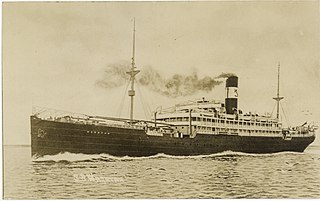
SS Waratah was a passenger and cargo steamship built in 1908 for the Blue Anchor Line to operate between Europe and Australia. In July 1909, on only her second voyage, the ship, en route along the coast of the Colony of Natal from Durban to Cape Town, disappeared with 211 passengers and crew aboard. No trace of the ship has ever been found.
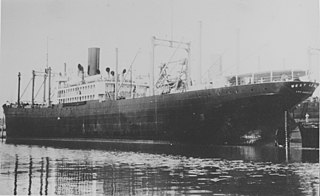
The USAT Meigs was a United States Army transport ship that was built in 1921 and sunk in Darwin Harbour in the first Japanese air raid against the Australia mainland on 19 February 1942.

The Australian Institute of Architects is a professional body for architects in Australia. The post-nominals of FRAIA (Fellow) and RAIA continue to be used.
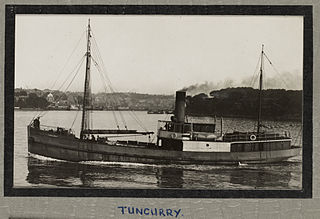
The Tuncurry was a wooden carvel screw steamer built in 1903 at Cape Hawke in the Australian state of New South Wales, that was wrecked when she sprang a leak whilst carrying explosives, cement, whiskey, jam and other general cargo between Sydney and Brisbane. She was lost off Barrenjoey Head, Broken Bay, New South Wales on 22 October 1916.

The Fitzroy was a steel-hulled steamship built in 1912 at Old Kilpatrick, Scotland in 1912. Thirty-one people were killed when Fitzroy capsized in a gale whilst carrying a general cargo between Coffs Harbour and Sydney off Cape Hawke, New South Wales on 26 June 1921.
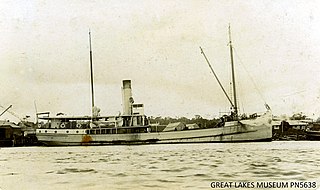
The Comboyne was a wooden screw steamer built in 1911 at Tuncurry, that was wrecked when it struck an object whilst carrying timber to Wollongong and was lost at approximately 1 mile (1.6 km) off Bass Point, Shellharbour, New South Wales on 27 November 1920.

HMAS Allenwood (FY18) was an auxiliary minesweeper operated by the Royal Australian Navy (RAN) during World War II. She was launched in 1920 by Ernst Wright at Tuncurry, New South Wales, Australia as Allenwood for Allen Taylor and Co. Ltd. The ship operated along the east coast of Australia, and was requisitioned by the RAN on 27 July 1941. She was returned to her owners in 1946 before being wrecked near Norah Head on 14 September 1951.
Bow, McLachlan and Company was a Scottish marine engineering and shipbuilding company that traded between 1872 and 1932.

HMAS Mallina was a 3,213 GRT cargo ship built by Harland & Wolff, Belfast in 1909 as Mallina for the Australian United Steam Navigation Company for the Rockhampton to Sydney cargo route. She was requisitioned by the Royal Australian Navy in 1914, as a store carrier and collier. She was returned to her owners in 1915. She was sold in 1935 to Machida Shokai Kisen Kaisha, Japan and renamed Seiko Maru, before being sold to Kita Nippon Kisen Kaisha and renamed Siberia Maru No. 3, which was later shortened to Siberian Maru. While steaming in the Sulu Sea, Philippines on 24 September 1944, she was attacked by American aircraft of Task Force 38 and sunk with the loss of 158 of the 2,382 people on board.
The Cockatoo Docks & Engineering Company was a ship building and maintenance company which operated the Cockatoo Island Dockyard on Cockatoo Island in Sydney, Australia between 1933 and 1992.
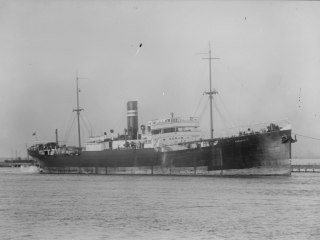
SS Canastota was a British-flagged, coal-burning, two-masted, steel screw, cargo steamer of 4,904 gross register tons (GRT) and 3,139 net register tons (NRT).

SS Collaroy was an iron paddle steamer which often travelled between Newcastle and Sydney. The ship was named after a sheep station near Cassilis in the Hunter Valley, Australia. It was launched in 1853 in Birkenhead, England. The ship's name is now the location of the present day suburb of Collaroy.

John Wright and Son was a former shipyard located in Tuncurry, Australia between 1875 and 1958.

John Wright was a 19th-century Australian shipbuilder, sawmiller and businessman.

SS Osterley was a steam ocean liner owned by the Orient Steam Navigation Company. She was built by the London and Glasgow Shipbuilding Company at Clydebank, Scotland in 1909 for a passenger service between London and Australia via the Suez Canal.

Sixty-miler (60-miler) is the colloquial name for the ships that were used in the coastal coal trade of New South Wales, Australia. The sixty milers delivered coal to Sydney Harbour from ports and ocean jetties to the north and south of Sydney. The name refers to the approximate distance by sea from the Hunter River to Sydney.

Langton Grange was a refrigerated steam cargo ship built in 1896 by the Workman, Clark & Co. of Belfast for Houlder Brothers & Co. of London to transport meat and other produce from Australia and South America to United Kingdom.
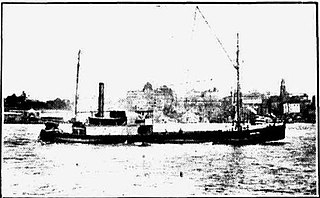
The Queen Bee was a wooden carvel Twin-screw steamer built in 1907 at Davistown, New South Wales, that was wrecked when she sprang a leak whilst carrying coal other general cargo between Sydney and Newcastle, New South Wales. She was lost off Barrenjoey Head, Broken Bay, New South Wales on 2 September 1922.

Kareela was a "K-class" ferry on Sydney Harbour. Launched in 1905, the double-ended timber-hulled steamer was built for Sydney Ferries Limited in response to the early twentieth century boom in cross-harbour ferry travel prior to the opening of the Sydney Harbour Bridge. She was the first of Sydney Ferries Limited's boats to have a fully enclosed upper deck.


















